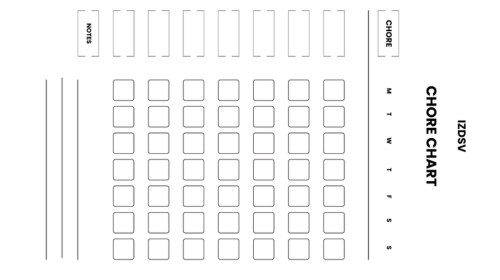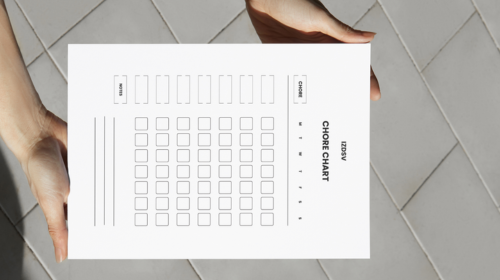Simple Color-Coded Chore Chart for Kids
Color-Coded Chore Chart for Kids
A color-coded chore chart is a visual system that uses different colors to represent various aspects of household tasks, making it easy for children to understand their responsibilities at a glance. This approach transforms mundane chores into an engaging, organized activity that kids can follow independently.
- Green tasks – Daily essentials like making beds, brushing teeth, or feeding pets
- Blue tasks – Weekly responsibilities such as taking out trash, watering plants, or organizing toys
- Yellow tasks – Fun or creative chores like helping with cooking, decorating, or garden work
- Red tasks – Important safety-related duties like putting away sharp objects or cleaning up spills
- Purple tasks – Special occasion or seasonal chores like holiday decorating or deep cleaning
- Use stickers or magnets – Children can move colored markers or place stickers when tasks are completed
- Create age-appropriate sections – Assign simpler colors and tasks for younger children, more complex ones for older kids
- Include visual icons – Add pictures alongside colors for non-reading children to understand their tasks
Importance of Chore Charts
Chore charts serve as fundamental tools for teaching children responsibility, time management, and the value of contributing to family life. They provide structure and clear expectations while building essential life skills that children will carry into adulthood.
- Develops responsibility – Children learn to take ownership of their duties and understand consequences
- Builds self-confidence – Completing tasks successfully gives kids a sense of accomplishment and capability
- Teaches time management – Kids learn to prioritize tasks and manage their daily schedules effectively
- Establishes routines – Creates predictable patterns that help children feel secure and organized
- Promotes family teamwork – Shows children they’re valuable contributors to household functioning
- Reduces parent stress – Eliminates constant reminding and nagging about incomplete tasks
- Prepares for independence – Builds skills necessary for future self-sufficiency and adult responsibilities
- Creates accountability – Visual tracking helps children see their progress and areas for improvement
Benefits of Color-Coding
Color-coding transforms abstract concepts into concrete, visual information that children’s brains can process more quickly and retain more effectively. This system reduces confusion and makes task management feel less overwhelming while adding an element of fun to household responsibilities.
- Visual clarity – Different colors instantly communicate task categories, difficulty levels, or completion status
- Faster comprehension – Children can understand their responsibilities at a glance without reading detailed instructions
- Appeals to different learning styles – Especially beneficial for visual learners who process information better through colors and patterns
- Reduces overwhelm – Breaking tasks into color categories makes large lists feel more manageable and less intimidating
- Encourages independence – Kids can follow the system without constant parental guidance or explanation
- Makes it fun and engaging – Bright colors and visual elements transform chores from boring duties into interactive activities
- Improves memory retention – Color associations help children remember their tasks more effectively than text alone
- Accommodates non-readers – Young children who cannot read can still understand and follow the system through color recognition
Step-by-Step Guide to Creating a Color-Coded Chore Chart
Step 1: Determine Chores
The foundation of an effective chore chart begins with carefully selecting age-appropriate tasks that match your child’s developmental abilities and your family’s specific needs. This step requires an honest assessment of what your children can realistically accomplish while ensuring the chores contribute meaningfully to household functioning.
- Assess your child’s age and abilities – Consider fine motor skills, attention span, and physical capabilities when selecting tasks
- List all household tasks – Write down everything from daily maintenance to weekly deep cleaning that needs regular attention
- Categorize by frequency – Separate tasks into daily, weekly, bi-weekly, and monthly responsibilities
- Consider safety requirements – Ensure all assigned chores are safe for your child’s age group and skill level
- Match tasks to interests – Align chores with your child’s natural preferences when possible (creative kids might enjoy organizing, active kids might prefer outdoor tasks)
- Start small and build up – Begin with 2-3 simple tasks and gradually add more as children demonstrate consistency
- Include both independent and collaborative tasks – Mix chores they can do alone with ones that involve helping parents
- Balance fun and necessary tasks – Combine enjoyable activities with essential but less exciting responsibilities
Step 2: Choose Colors
Color selection forms the visual language of your chore chart system, so choosing meaningful and intuitive color associations helps children quickly understand and remember their responsibilities. The colors should be distinct enough to avoid confusion while creating logical connections between hue and task type.
- Assign colors by task category – Use green for daily basics, blue for weekly tasks, yellow for fun activities, red for urgent/important duties
- Consider color psychology – Choose calming blues for routine tasks, energizing yellows for creative chores, reliable greens for daily habits
- Ensure sufficient contrast – Select colors that are easily distinguishable, especially important for children with visual processing differences
- Use your child’s favorite colors – Incorporate colors they love to increase engagement and ownership of the system
- Keep it simple with 4-6 colors maximum – Too many colors create confusion and defeat the purpose of visual clarity
- Test color visibility – Make sure chosen colors show up clearly on your chart background and under your home’s lighting
- Consider seasonal variations – You might rotate color schemes seasonally to maintain interest and freshness
- Create a color legend – Make a reference key that clearly explains what each color represents
Step 3: Design the Chart
The physical design of your color coded chore chart determines how effectively children can interact with and understand the system on a daily basis. A well-designed chart balances visual appeal with functional clarity, making it both attractive enough to engage children and practical enough for consistent use.
- Choose the right size and location – Make it large enough to read easily and place it at your child’s eye level in a high-traffic area
- Select durable materials – Use laminated paper, dry-erase boards, or magnetic boards that can withstand daily handling and updates
- Create clear sections – Divide the chart into logical areas for different children, days of the week, or task categories
- Add visual elements – Include pictures, icons, or symbols alongside text to help non-readers understand their tasks
- Design tracking mechanisms – Incorporate checkboxes, star stickers, magnetic pieces, or other ways for children to mark completion
- Make it interactive – Consider moveable pieces, flip charts, or digital elements that children can physically manipulate
- Include progress indicators – Add weekly or monthly summary sections where children can see their overall performance
- Leave room for growth – Design with space to add new chores or family members as needs change
Step 4: Implement the Chart
Successful implementation requires introducing the system gradually while building excitement and understanding around how the chart works in your family’s daily routine. This phase determines whether your carefully planned system becomes a helpful tool or an abandoned project.
- Introduce with enthusiasm – Present the chart as an exciting new family system rather than additional work or rules
- Explain the color system clearly – Walk through each color category and what it means, using specific examples from their assigned tasks
- Demonstrate proper usage – Show children exactly how to mark completed tasks and where to find their daily responsibilities
- Start with a trial period – Implement for one week initially, allowing everyone to adjust and learn the system without pressure
- Establish consistent timing – Set specific times for checking charts (morning review, evening completion check) to build a routine
- Provide immediate feedback – Acknowledge completed tasks promptly and offer gentle reminders for missed ones
- Create celebration moments – Recognize successful chart completion with praise, family acknowledgment, or small rewards
- Stay patient during adjustment – Expect some confusion and mistakes initially as everyone learns the new system
Step 5: Review and Adjust
Regular evaluation and modification ensure your chore chart system continues to meet your family’s evolving needs while maintaining children’s engagement and motivation. This ongoing process transforms a static tool into a dynamic system that grows with your family.
- Schedule weekly family meetings – Set aside time to discuss what’s working well and what needs improvement in the chart system
- Track completion patterns – Notice which tasks are consistently completed and which are frequently missed or forgotten
- Assess age appropriateness regularly – Adjust task difficulty and expectations as children grow and develop new capabilities
- Gather feedback from children – Ask kids what they like, dislike, and would change about their current chore assignments
- Modify colors or categories – Update the color system if certain associations aren’t working or if family needs change
- Add seasonal variations – Incorporate holiday tasks, summer outdoor chores, or school-year specific responsibilities as needed
- Celebrate improvements – Acknowledge when children show growth in responsibility or when the system helps family functioning
- Be flexible with changes – Don’t hesitate to completely revamp the system if it’s not serving your family’s needs effectively
Tips for Effective Use of Chore Charts
Involve Your Kids in the Process
When children participate in creating their own chore chart system, they develop genuine ownership and investment in following through with their responsibilities. This collaborative approach transforms the chart from a parent-imposed rule into a shared family agreement that children help design and maintain.
- Let them choose some of their own chores – Allow kids to select from appropriate options so they feel in control over their responsibilities
- Include them in color selection – Have children help pick which colors represent different task categories or difficulty levels
- Ask for their input on chart design – Get their opinions on layout, decorations, and visual elements that will make the chart appealing
- Have them help create the physical chart – Let kids draw pictures, write labels, or decorate the chart to increase their connection to it
- Discuss timing and scheduling together – Work with children to determine realistic deadlines and when tasks should be completed
- Let them suggest rewards or incentives – Allow kids to propose what they’d like to earn for consistent chart completion
- Include them in weekly reviews – Make chart evaluation a family discussion where children can voice concerns and suggestions
- Give them ownership of updates – Teach children to mark their own completed tasks and track their own progress
Set Clear Expectations
Ambiguous instructions and unclear standards create frustration for both parents and children, leading to conflicts and inconsistent results. Crystal-clear expectations eliminate guesswork and help children understand exactly what success looks like for each assigned task.
- Define what “done” means for each chore – Specify exactly how clean a room should be or what steps constitute “feeding the pet”
- Establish specific timeframes – Set clear deadlines like “before breakfast” or “by 7 PM” rather than vague timing like “sometime today”
- Create step-by-step instructions – Break complex tasks into numbered steps that children can follow independently
- Show rather than tell – Demonstrate proper technique for new chores and have children practice while you watch
- Post visual reminders – Include pictures or diagrams showing what completed tasks should look like
- Address quality standards – Explain the difference between rushed completion and thorough job performance
- Clarify consequences for missed tasks – Make it clear what happens when chores aren’t completed on time or to standard
- Be consistent with enforcement – Apply the same standards and consequences every day to avoid confusion and testing
Use Positive Reinforcement
Positive reinforcement creates lasting motivation by helping children associate chore completion with good feelings and desirable outcomes. This approach builds intrinsic motivation over time while making the entire chore system feel rewarding rather than punitive.
- Offer immediate praise for completion – Acknowledge completed tasks right away with specific, enthusiastic recognition
- Use a variety of rewards – Mix verbal praise, stickers, extra privileges, small treats, and special activities to maintain interest
- Focus on effort as much as results – Praise children for trying hard and improving, not just for perfect completion
- Create milestone celebrations – Recognize weekly or monthly achievements with special family activities or privileges
- Make rewards meaningful to each child – Tailor incentives to individual interests and preferences for maximum motivation
- Gradually shift from external to internal rewards – Help children develop pride in contributing to family life beyond earning prizes
- Avoid punishment-focused systems – Emphasize what children gain from completing chores rather than what they lose from missing them
- Celebrate the whole family’s success – Acknowledge when everyone works together effectively and the household runs smoothly




